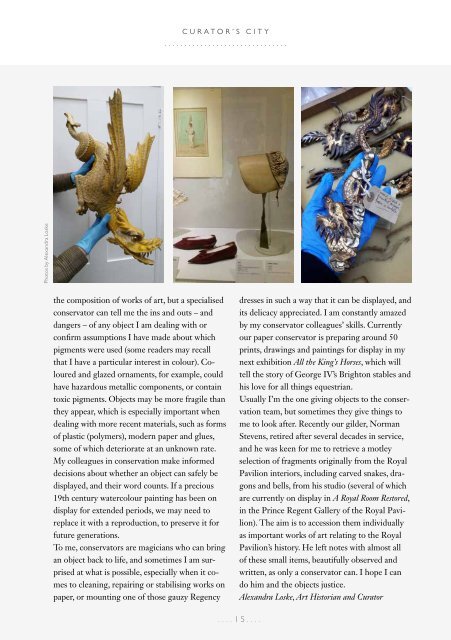Viva Brighton Issue #73 March 2019
- No tags were found...
You also want an ePaper? Increase the reach of your titles
YUMPU automatically turns print PDFs into web optimized ePapers that Google loves.
CURATOR’S CITY<br />
...............................<br />
Photos by Alexandra Loske<br />
the composition of works of art, but a specialised<br />
conservator can tell me the ins and outs – and<br />
dangers – of any object I am dealing with or<br />
confirm assumptions I have made about which<br />
pigments were used (some readers may recall<br />
that I have a particular interest in colour). Coloured<br />
and glazed ornaments, for example, could<br />
have hazardous metallic components, or contain<br />
toxic pigments. Objects may be more fragile than<br />
they appear, which is especially important when<br />
dealing with more recent materials, such as forms<br />
of plastic (polymers), modern paper and glues,<br />
some of which deteriorate at an unknown rate.<br />
My colleagues in conservation make informed<br />
decisions about whether an object can safely be<br />
displayed, and their word counts. If a precious<br />
19th century watercolour painting has been on<br />
display for extended periods, we may need to<br />
replace it with a reproduction, to preserve it for<br />
future generations.<br />
To me, conservators are magicians who can bring<br />
an object back to life, and sometimes I am surprised<br />
at what is possible, especially when it comes<br />
to cleaning, repairing or stabilising works on<br />
paper, or mounting one of those gauzy Regency<br />
dresses in such a way that it can be displayed, and<br />
its delicacy appreciated. I am constantly amazed<br />
by my conservator colleagues’ skills. Currently<br />
our paper conservator is preparing around 50<br />
prints, drawings and paintings for display in my<br />
next exhibition All the King’s Horses, which will<br />
tell the story of George IV’s <strong>Brighton</strong> stables and<br />
his love for all things equestrian.<br />
Usually I’m the one giving objects to the conservation<br />
team, but sometimes they give things to<br />
me to look after. Recently our gilder, Norman<br />
Stevens, retired after several decades in service,<br />
and he was keen for me to retrieve a motley<br />
selection of fragments originally from the Royal<br />
Pavilion interiors, including carved snakes, dragons<br />
and bells, from his studio (several of which<br />
are currently on display in A Royal Room Restored,<br />
in the Prince Regent Gallery of the Royal Pavilion).<br />
The aim is to accession them individually<br />
as important works of art relating to the Royal<br />
Pavilion’s history. He left notes with almost all<br />
of these small items, beautifully observed and<br />
written, as only a conservator can. I hope I can<br />
do him and the objects justice.<br />
Alexandra Loske, Art Historian and Curator<br />
....15....


















